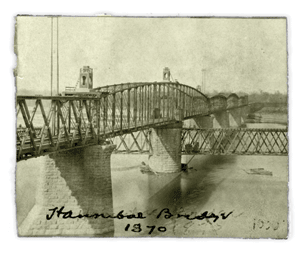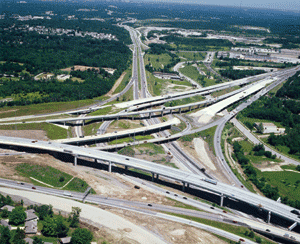For all the glamour projects that are dazzling greater Kansas City--the speedways, the arenas, the corporate headquarters, the sporting goods stores with their own lakes--the one project that will most surely transform the area is usually talked about only by the people who pass through it and then often in mutters.
This project, in its more primitive form, went by the unholy name of the "Grandview Triangle." For the record, the intersection of I-470, I-435 and U.S. Highway 71, plus seven local routes, comprise the basic interchanges. With the possible exception of the Bermuda Triangle, this may have been North America's least loved triangle. Indeed, not since Eddie Fisher abandoned Debbie Reynolds for Liz Taylor has any triangle gotten so much bad publicity. The Grandview Triangle reaped such bad press for a good reason: it performed a vital function poorly, so poorly in fact that it allowed neighboring Kansas to prosper at Missouri's expense.

The Hannibal Bridge officially opened on July 3, 1869 roughly where the Broadway Bridge now stands. The bridge, as it was known, firmly cemented Kansas City’s position as the crossroads city of the central Midwest and assured its relative success.
The function in question is that of the "crossroads." Like most cities, Kansas City began as a crossroads. One of the most discussed but least understood moments in Kansas City history involves the crossing of the Missouri River by the first railroad bridge in 1869. The bridge itself was not particularly novel. Nor was this the first railroad to Kansas City. What gave the bridge its transformational power was that it allowed the north-south rail line to cross the existing east-west one. That enabled Kansas City to become the first crossroads city on the great bend of the Missouri. Had the bridge crossed elsewhere, Kansas City would likely have been another Atchison or Weston.
History repeats itself
Likewise, the transforming event in Johnson County history was not so much the extension of I-35 South, although that was an essential part of it, but rather the wrapping of I-435 west through what was then largely virgin territory. Sun publisher Steve Rose tells the story of his family's decision to build their plant at the crossroads of I-435 and Metcalf, an idea that struck most observers at the time as folly. Little did anyone realize that I-435, which was built as a bypass, would turn into Overland Park's Main Street. And that a series of crossroads at Metcalf, U.S. Highway 69 Highway, and I-35 would make that extended crossroads development the most dynamic in the metropolitan area for the last quarter of the 20th century.

When complete, the Grandview Triangle will have reduced congestion by adding more lanes, by improving shoulders, by widening bridges, by enhancing ramps, and by adding direct ramps to Red Bridge Road as well as a Longview Road bridge over Highway 71.
Meanwhile, Grandview, just south of the dreaded triangle that bears its name, strangled on exhaust fumes. Despite great early promise, the city simply could not find traction. Just north of the triangle the city of Kansas City was building not gleaming office parks but massive waste dumps. East and west of the triangle not much of anything happened either. That is all about to change, and the change could be far reaching.
The change begins with the name. The project web site insists on calling the new entity the KC Triangle, but just as the famed Hannibal Bridge quickly became known as "the bridge," the new configuration will likely be known as "the Triangle."
When complete, the new design will have reduced congestion by adding more lanes, by improving shoulders, by widening bridges, by enhancing ramps, and by adding direct ramps to Red Bridge Road as well as a Longview Road bridge over Highway 71.
The transformation represents a quiet triumph of American engineering. The essential challenge has been to transform an intersection that badly handled 250,000 cars a day to one that will gracefully handle more than 400,000 a day. The tricky part is that the intersection has to remain open while this conversion is taking place. Hats off to the clever folks at MoDOT and HNTB who have made this happen. Indeed, even while under construction, traffic overall moves more smoothly than before work began in 2001.
To get some sense of the complexity of the Triangle, most interchanges of two interstate highways are composed of 12 movements (exits, entrances and through traffic). The old jury-rigged Triangle had 64 movements.
The construction project itself covers 550 acres, or very nearly a square mile. It will use 660,000 square yards of concrete pavement. This translates into 70 lane miles of new pavement. There will be 22 new bridges, 293 new bridge columns, 2,300,000 cubic yards of embankment, 248,000 square feet of MSE retaining walls, and 99,000 square feet of concrete sound walls. To make this all happen, 1,900,000 cubic yards of soil and 700,000 cubic yards of rock had to be excavated. As a point of comparison, the Great Pyramid of Egypt covered 13 acres with 590,000 stone blocks. Our guys could have built it during their lunch breaks.
The third major phase of the project is scheduled for completion in late 2006. There will be later ancillary phases as well. To further reduce congestion in the Triangle, two alternative east-west routes will receive substantial improvements before most Triangle construction ends.
One is Missouri Highway 150, a four-lane, divided east-west highway that
runs from the state line to U.S. Highway 71 just south of Grandview. In a
telling comment, MoDOT argues that this road "offers a convenient alternative
for Cass County commuters who work in Johnson County, Kan." Unmentioned is
even the possibility that Johnson County workers might be commuting to Cass
County, especially as the crossroads of U.S. Highway 71 and Missouri Highway
150 take shape. This mindset is likely to change in the near future.
